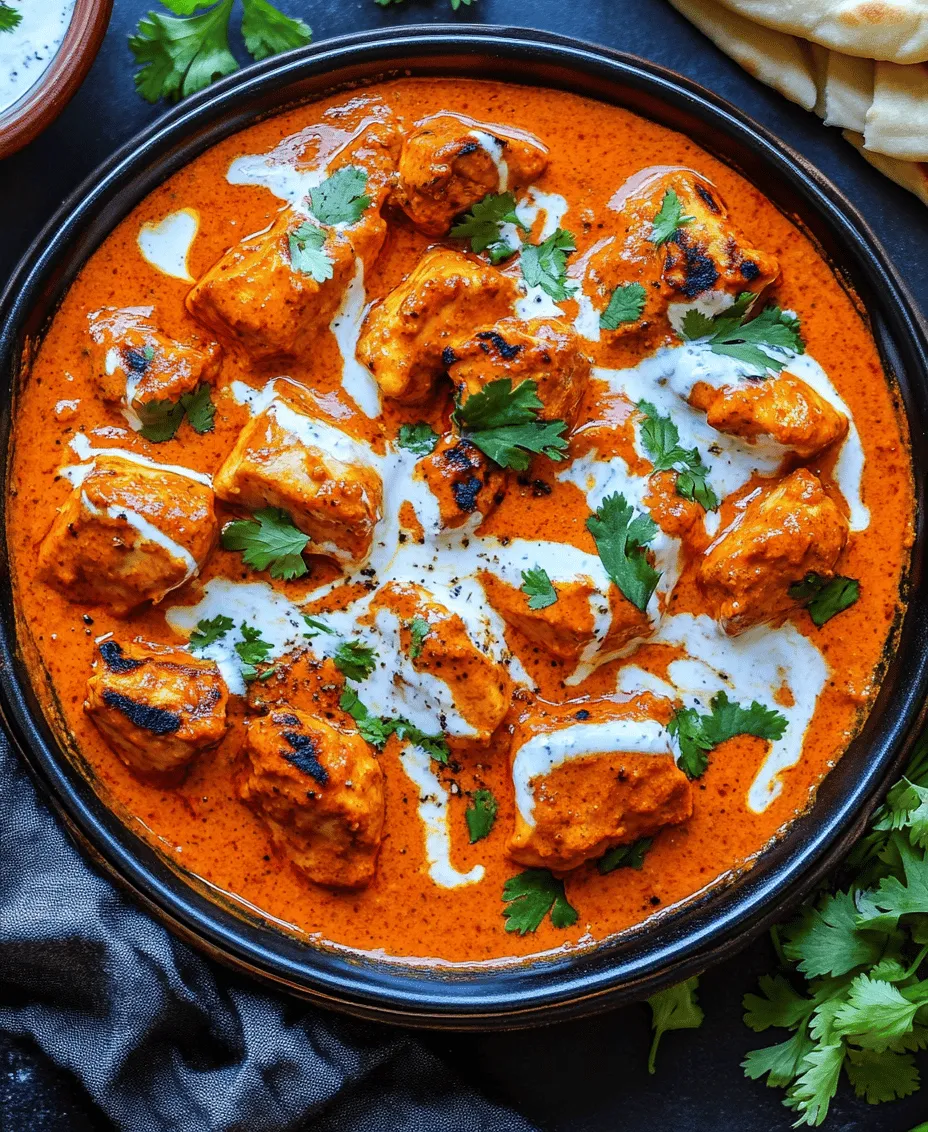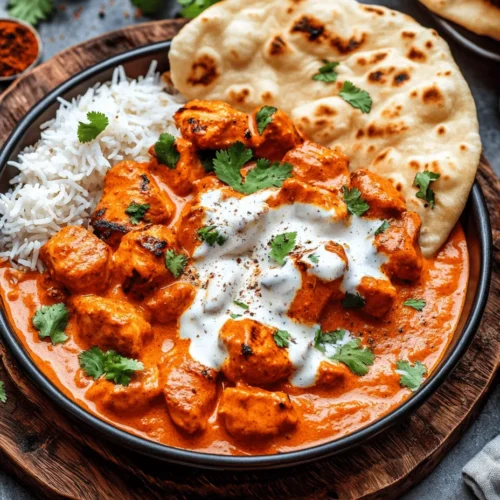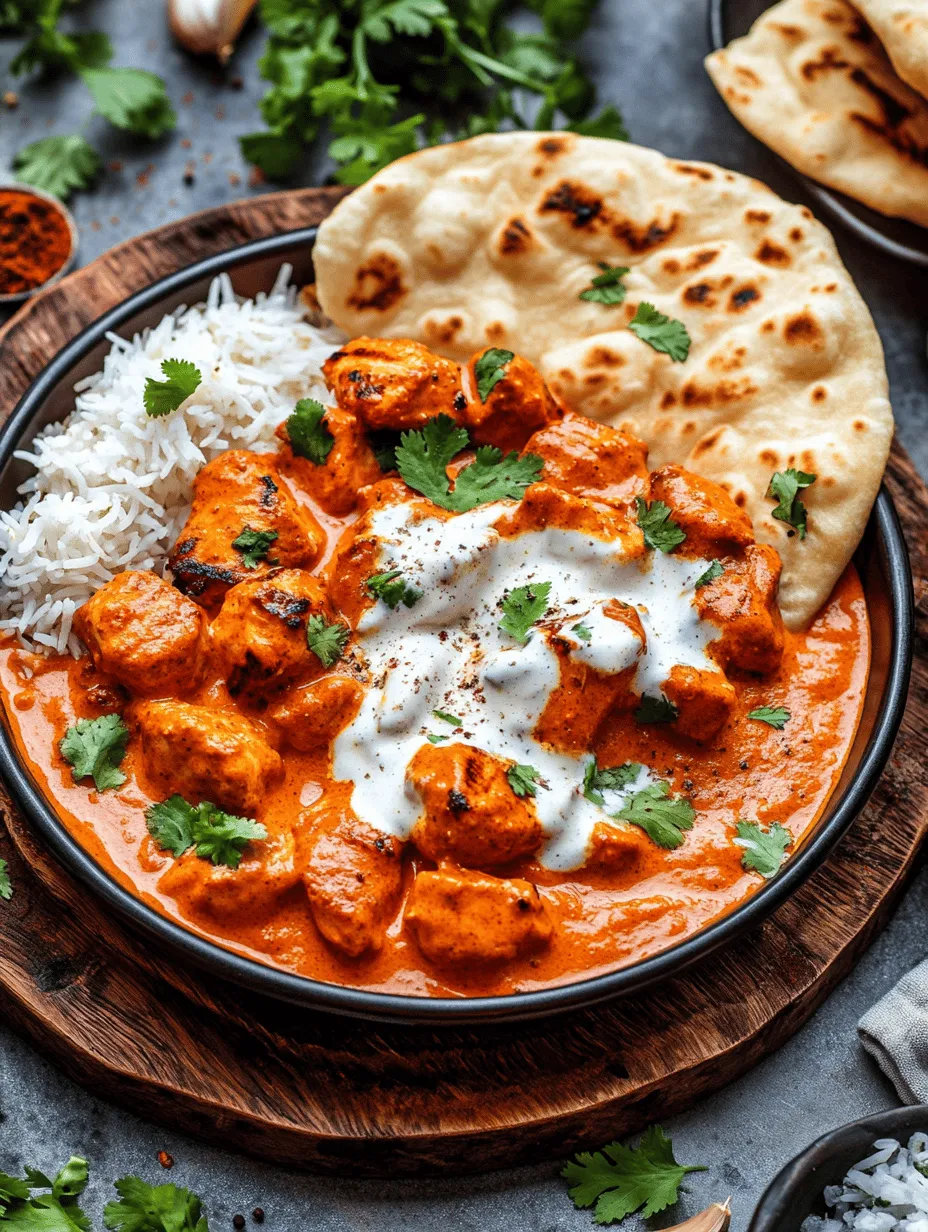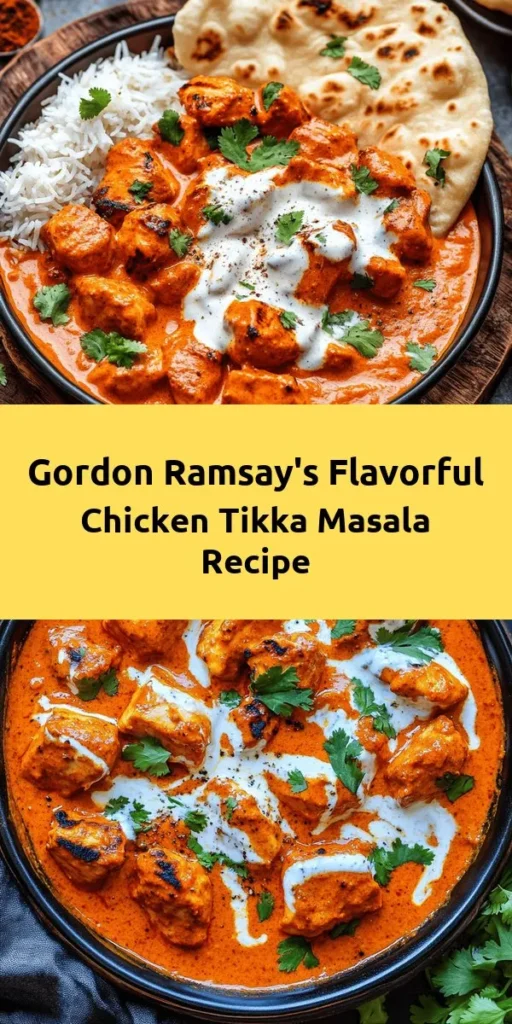Introduction
Explore the rich and aromatic world of Indian cuisine with Gordon Ramsay’s Chicken Tikka Masala, a dish that perfectly balances spices, creamy textures, and tender chicken. This beloved recipe not only captures the essence of traditional Indian cooking but also offers a modern twist that will impress your family and friends. Chicken Tikka Masala has transcended boundaries, becoming a staple in both Indian restaurants and home kitchens worldwide. The dish boasts a perfect harmony of marinated chicken, a fragrant and spiced sauce, and a delightful presentation that invites everyone to dig in.
In this article, we will delve into the details of this mouthwatering dish, providing you with a comprehensive guide to making it at home. We will cover the essential steps, from the marinade preparation to cooking techniques, ensuring that you achieve restaurant-quality results in your own kitchen. Whether you are a seasoned cook or a culinary novice, this recipe will empower you to recreate this classic dish with ease.
Understanding the Essence of Chicken Tikka Masala
The Historical Background of Chicken Tikka Masala
The origins of Chicken Tikka Masala are somewhat debated, with various claims about its birthplace. While many believe it originated in India, others argue that it was created in the UK by Indian chefs catering to British tastes. The dish likely evolved from traditional Indian chicken tikka, which consists of marinated chicken pieces that are grilled or baked. The addition of rich tomato-based sauce, cream, and spices transformed it into a dish that is now celebrated globally.
This fusion of Indian and British culinary practices is a testament to the multicultural nature of modern cuisine, showcasing how flavors can transcend geographical boundaries. The dish gained prominence in the 1970s and has since become one of the UK’s most popular dishes, often referred to as the unofficial national dish.
Cultural Significance in Indian and British Cuisine
Chicken Tikka Masala holds a unique place in both Indian and British culinary traditions. In India, it represents the diverse and rich flavors found in traditional cooking, showcasing the art of marination and spice blending. The use of yogurt in the marinade not only tenderizes the chicken but also infuses it with flavor, a technique that has been passed down through generations.
In Britain, the dish symbolizes the country’s evolving food landscape, where British diners embraced Indian flavors and adapted them to their palate. Its creamy, mild sauce caters to a wide range of taste preferences, making it accessible to those who may be hesitant about more traditional Indian dishes. This cross-cultural relationship highlights the importance of food as a medium for connection and understanding across different cultures.
Why It Has Become a Global Favorite
The universal appeal of Chicken Tikka Masala lies in its comforting flavors and satisfying textures. The combination of tender chicken, a richly spiced sauce, and the creamy finish makes it a favorite across various demographics. Moreover, it is often served with rice or naan, allowing for a complete and satisfying meal.
The dish’s adaptability also contributes to its popularity. Chefs and home cooks alike can tweak the spice levels, substitute ingredients, or add vegetables to cater to different dietary needs and preferences. Its ability to be both a warming comfort food and an elegant dish for special occasions makes Chicken Tikka Masala an enduring favorite in homes and restaurants around the world.
Ingredients Breakdown
To create Gordon Ramsay’s Chicken Tikka Masala, it is essential to gather the right ingredients that will enhance the flavors and textures of the dish. The recipe comprises two primary components: the chicken marinade and the sauce.
A Detailed Look at the Chicken Marinade
The chicken marinade is crucial in developing the dish’s signature flavor profile.
– Importance of Yogurt in Tenderizing Chicken: One of the key ingredients in the marinade is plain yogurt. Yogurt not only adds creaminess to the marinade but also plays a significant role in tenderizing the chicken. The lactic acid in yogurt breaks down the protein fibers, resulting in tender and juicy chicken. This process is essential, especially when cooking chicken, as it helps achieve that melt-in-your-mouth texture that is so desirable in this dish.
– The Role of Spices in Flavor Development: The marinade is also infused with a blend of spices, including cumin, coriander, turmeric, garam masala, and cayenne pepper. These spices are critical for flavor development, adding depth and complexity to the dish. The spices not only enhance the taste of the chicken but also create a beautiful color, which is visually appealing when served.
The Sauce Ingredients Explained
The sauce that accompanies the marinated chicken is equally important in achieving the perfect Chicken Tikka Masala.
– The Significance of Fresh Ingredients: A successful tikka masala sauce relies on fresh ingredients. Fresh tomatoes, garlic, and ginger form the base of the sauce, providing a vibrant flavor that canned alternatives cannot match. The use of fresh produce ensures that the sauce is bright, aromatic, and full of life, elevating the final dish.
– Impact of Heavy Cream on the Sauce’s Texture: Heavy cream is another essential component of the sauce. It adds richness and creaminess, balancing the acidity of the tomatoes and the heat from the spices. The cream not only contributes to the sauce’s luxurious texture but also mellows the overall flavor, making it approachable for those who may be sensitive to spicy dishes.
Marinating the Chicken
Marination is a crucial step in the preparation of Chicken Tikka Masala. It allows the flavors to penetrate the chicken, ensuring that every bite is packed with taste.
The Science Behind Marination
– How Long to Marinate for Optimal Flavor: For optimal flavor, it is recommended to marinate the chicken for at least 1 to 2 hours, but overnight marination yields the best results. This extended time allows the spices and yogurt to fully infuse the chicken, resulting in a more flavorful and tender end product.
– Tips for Achieving Tender and Flavorful Chicken: To ensure your chicken is both tender and flavorful, consider these tips:
– Cut the chicken into uniform pieces to ensure even marination.
– Use bone-in, skinless chicken thighs for a juicier texture, or chicken breasts for a leaner option.
– Make sure to coat the chicken thoroughly with the marinade, ensuring every piece is well-covered for maximum flavor.
Step-by-Step Guide to Preparing the Marinade
1. Mixing the Ingredients: In a large mixing bowl, combine the yogurt with the spices: cumin, coriander, turmeric, garam masala, cayenne, salt, and a squeeze of lemon juice. Stir until you have a smooth and consistent mixture.
2. Coating Chicken Cubes Effectively: Add the chicken pieces to the marinade, using your hands or a spatula to coat them evenly. Make sure each piece is well covered in the marinade, ensuring that the flavors penetrate throughout the meat.
3. Covering and Refrigerating: Cover the bowl with plastic wrap or transfer the marinated chicken to a resealable plastic bag. Place it in the refrigerator and allow it to marinate for the desired time, ideally overnight for the best results.
Grilling the Chicken
Once your chicken has marinated, the next step is to cook it, and grilling is one of the best methods to achieve that signature char and smoky flavor.
Choosing the Right Cooking Method: Grill vs. Oven
– Pros and Cons of Each Method: Grilling offers a distinct flavor due to the charred exterior, while baking in the oven can be more convenient and allows for cooking larger batches at once. Both methods can yield delicious results, but grilling may require more attention to ensure that the chicken does not dry out.
– Temperature Settings for Perfect Grilling: If you choose to grill your chicken, preheat your grill to medium-high heat (around 400°F to 450°F). This temperature is ideal for achieving a nice sear on the chicken, locking in moisture and flavor.
Preparing the Grill or Oven
Before grilling, ensure your grill grates are clean and well-oiled to prevent sticking. If using an oven, line a baking sheet with aluminum foil for easy cleanup.
Regardless of the method you choose, ensure that your chicken is cooked to an internal temperature of 165°F to ensure food safety.
With these foundational steps laid out, you can confidently move forward in creating Gordon Ramsay’s Chicken Tikka Masala. The next stages will involve preparing the sauce and combining the elements for a deliciously satisfying dish that is bound to impress anyone at your dining table.

Essential Tips for Achieving the Ideal Char
When preparing Gordon Ramsay’s Chicken Tikka Masala, achieving the perfect char on the chicken is crucial for depth of flavor and authentic taste. Here are some essential tips to help you get that delightful char:
1. High Heat Cooking: When grilling or broiling the chicken, ensure your cooking method is at a high temperature. This helps to sear the chicken quickly, creating a beautiful char while keeping the inside juicy.
2. Preheat Your Grill or Oven: Whether you are using a grill or an oven, preheating is key. For grills, aim for a temperature of around 400°F (200°C). If using an oven, set it to broil. This initial heat ensures the chicken cooks evenly and develops a nice crust.
3. Skewering Technique: When skewering your chicken, make sure the pieces are not overcrowded. They should have enough space to allow hot air to circulate around them, promoting even cooking and char.
4. Marination Time: A longer marination time enhances the flavor and tenderness of the chicken. Ideally, marinate the chicken for at least 4 hours, but overnight is even better for maximum flavor infusion.
Safety Tips for Skewering Chicken
While skewering chicken, safety should be a priority. Here are a few tips to keep in mind:
1. Use Metal Skewers: Metal skewers conduct heat and help cook the chicken more evenly, which can also help prevent any bacterial growth that may occur with wooden skewers.
2. Soak Wooden Skewers: If you prefer using wooden skewers, soak them in water for at least 30 minutes before use. This prevents them from burning on the grill.
3. Clean Hands and Surfaces: Always wash your hands and any surfaces that come into contact with raw chicken to prevent cross-contamination. Use separate cutting boards for raw meat and other ingredients.
4. Cook Thoroughly: Ensure that the chicken reaches an internal temperature of 165°F (74°C) before serving. A meat thermometer is a handy tool to ensure safety and doneness.
Crafting the Sauce
Building a rich and flavorful sauce is the heart of Chicken Tikka Masala. Each step contributes to the overall taste of the dish.
Building Flavor Layers through Sautéing
1. Importance of Cooking Onions Until Golden: Start your sauce by sautéing finely chopped onions in a bit of oil or ghee. Cook them until they turn a deep golden brown. This process caramelizes the sugars in the onions, adding sweetness and depth to your sauce.
2. Adding Garlic and Ginger at the Right Time: Once your onions are golden, add minced garlic and ginger. Sautéing these aromatics for just a minute will release their essential oils, which enhances the flavor profile of the sauce. Be careful not to let them burn, as this can lead to a bitter taste.
Toasting Spices for Maximum Flavor
1. Techniques for Releasing Essential Oils: Toasting spices is a crucial step in Indian cooking. Add your ground spices—cumin, coriander, turmeric, and garam masala—to the pan after the garlic and ginger. Toast them briefly to release their essential oils, which will infuse your sauce with rich flavors.
2. Timing for Adding Spices to Avoid Burning: The key to perfect toasted spices is timing. Add them immediately after the garlic and ginger, stirring continuously for about 30 seconds. This prevents the spices from burning, which can ruin the sauce.
Combining Chicken and Sauce
Once your chicken has been charred and your sauce is ready, it’s time for the final steps to create a harmonious dish.
1. Importance of Simmering Together: Combine the charred chicken with the sauce and allow the mixture to simmer for about 10-15 minutes. This step ensures that the chicken absorbs the sauce’s flavors, making each bite rich and satisfying.
2. How to Adjust Seasoning to Taste: After simmering, taste your Chicken Tikka Masala and adjust the seasoning as needed. You may want to add salt or a pinch of sugar to balance the acidity of the tomatoes. A splash of cream or yogurt can also enhance the sauce’s richness.
Serving Suggestions
To elevate your Chicken Tikka Masala experience, consider these serving suggestions:
Best Accompaniments for Chicken Tikka Masala
1. Traditional Options: Serve your Chicken Tikka Masala with fluffy basmati rice or warm naan bread. The rice absorbs the sauce beautifully, while naan serves as a delightful vehicle for scooping up the dish.
2. Creative Side Dishes: For a more adventurous meal, pair it with Indian-style side dishes like raita (yogurt sauce with cucumber and spices), samosas (fried or baked pastry filled with spiced potatoes or meat), or a fresh salad with mango chutney for a balancing sweetness.
Garnishing for Visual Appeal and Flavor Enhancement
1. The Role of Fresh Cilantro: A sprinkle of freshly chopped cilantro not only adds a burst of color but also brightens the flavors of your Chicken Tikka Masala. The herb’s fresh, slightly citrusy notes complement the spices beautifully.
2. Alternative Garnishes to Consider: You can also consider garnishing with a dollop of cream or yogurt, which adds richness and a nice contrast to the spices. Thinly sliced red onions or lime wedges can also enhance the dish visually and add a zesty kick.
Nutritional Insights
As with any dish, understanding the nutritional profile of Chicken Tikka Masala can help you make informed choices.
Caloric Breakdown of the Dish
The caloric content of Chicken Tikka Masala can vary based on portion size and ingredients. On average, a serving may contain around 400-600 calories, depending on the amount of cream or yogurt used.
Health Benefits of Key Ingredients
1. Chicken: A great source of protein, chicken helps build muscle and repair tissues.
2. Spices: Many spices used in Chicken Tikka Masala, such as turmeric and cumin, have anti-inflammatory properties and can aid digestion.
3. Tomatoes: Rich in antioxidants, particularly lycopene, tomatoes contribute to heart health and skin protection.
Tips for Making a Lighter Version if Desired
If you’re looking to lighten your Chicken Tikka Masala, consider the following tips:
1. Use Skinless Chicken Breasts: Opting for skinless chicken breasts instead of thighs can significantly reduce the fat content.
2. Reduce Cream or Yogurt: Use low-fat yogurt instead of heavy cream, or substitute with coconut milk for a lighter, dairy-free version.
3. Increase Vegetables: Add vegetables like bell peppers, spinach, or peas to increase the fiber content and make the dish more nutritious.
Conclusion
Gordon Ramsay’s Chicken Tikka Masala is not just a meal; it is an experience that brings people together. With its vibrant flavors and inviting aroma, this dish is sure to become a staple in your cooking repertoire. Whether you’re a seasoned chef or a novice in the kitchen, following this detailed guide will empower you to create a delicious Chicken Tikka Masala that embodies the richness of Indian cuisine. Enjoy the satisfaction of homemade cooking and share this delightful dish with those you love, celebrating the joy of good food and great company.



